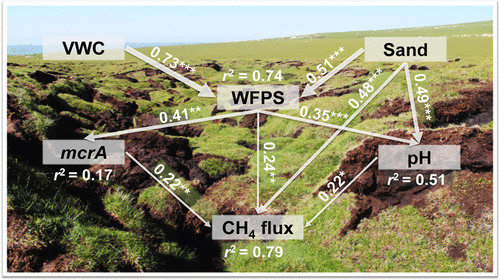当前位置:
X-MOL 学术
›
Environ. Sci. Technol.
›
论文详情
Our official English website, www.x-mol.net, welcomes your
feedback! (Note: you will need to create a separate account there.)
Changes in Methane Flux along a Permafrost Thaw Sequence on the Tibetan Plateau
Environmental Science & Technology ( IF 10.8 ) Pub Date : 2018-01-12 00:00:00 , DOI: 10.1021/acs.est.7b04979 Guibiao Yang 1, 2 , Yunfeng Peng 1 , David Olefeldt 3 , Yongliang Chen 1 , Guanqin Wang 1, 2 , Fei Li 1, 2 , Dianye Zhang 1, 2 , Jun Wang 1, 2 , Jianchun Yu 1, 2 , Li Liu 1, 2 , Shuqi Qin 1, 2 , Tianyang Sun 1, 2 , Yuanhe Yang 1, 2
Environmental Science & Technology ( IF 10.8 ) Pub Date : 2018-01-12 00:00:00 , DOI: 10.1021/acs.est.7b04979 Guibiao Yang 1, 2 , Yunfeng Peng 1 , David Olefeldt 3 , Yongliang Chen 1 , Guanqin Wang 1, 2 , Fei Li 1, 2 , Dianye Zhang 1, 2 , Jun Wang 1, 2 , Jianchun Yu 1, 2 , Li Liu 1, 2 , Shuqi Qin 1, 2 , Tianyang Sun 1, 2 , Yuanhe Yang 1, 2
Affiliation

|
Permafrost thaw alters the physical and environmental conditions of soil and may thus cause a positive feedback to climate warming through increased methane emissions. However, the current knowledge of methane emissions following thermokarst development is primarily based on expanding lakes and wetlands, with upland thermokarst being studied less often. In this study, we monitored the methane emissions during the peak growing seasons of two consecutive years along a thaw sequence within a thermo-erosion gully in a Tibetan swamp meadow. Both years had consistent results, with the early and midthaw stages (3 to 12 years since thaw) exhibiting low methane emissions that were similar to those in the undisturbed meadow, while the emissions from the late thaw stage (20 years since thaw) were 3.5 times higher. Our results also showed that the soil water-filled pore space, rather than the soil moisture per se, in combination with the sand content, were the main factors that caused increased methane emissions. These findings differ from the traditional view that upland thermokarst could reduce methane emissions owing to the improvement of drainage conditions, suggesting that upland thermokarst development does not always result in a decrease in methane emissions.
中文翻译:

青藏高原多年冻土融化过程中甲烷通量的变化
多年冻土融化改变了土壤的物理和环境条件,因此可能通过增加甲烷排放量而对气候变暖产生积极的反馈。但是,目前有关热岩溶发展后甲烷排放的知识主要是基于不断扩大的湖泊和湿地,而对高地热岩溶的研究较少。在这项研究中,我们监测了藏族沼泽草甸热侵蚀沟渠中融雪序列中连续两年高峰生长季节的甲烷排放量。两年都有一致的结果,融化的早期和中期(融化后3至12年)甲烷排放量低,与未扰动的草地相似,而融化后期(融化后20年)的甲烷排放量为3.5。倍高。本身,再加上含沙量,是造成甲烷排放增加的主要因素。这些发现与传统观点不同,传统观点认为由于排水条件的改善,陆地热岩溶可以减少甲烷的排放,这表明陆地热岩溶的发展并不总是导致甲烷排放的减少。
更新日期:2018-01-12
中文翻译:

青藏高原多年冻土融化过程中甲烷通量的变化
多年冻土融化改变了土壤的物理和环境条件,因此可能通过增加甲烷排放量而对气候变暖产生积极的反馈。但是,目前有关热岩溶发展后甲烷排放的知识主要是基于不断扩大的湖泊和湿地,而对高地热岩溶的研究较少。在这项研究中,我们监测了藏族沼泽草甸热侵蚀沟渠中融雪序列中连续两年高峰生长季节的甲烷排放量。两年都有一致的结果,融化的早期和中期(融化后3至12年)甲烷排放量低,与未扰动的草地相似,而融化后期(融化后20年)的甲烷排放量为3.5。倍高。本身,再加上含沙量,是造成甲烷排放增加的主要因素。这些发现与传统观点不同,传统观点认为由于排水条件的改善,陆地热岩溶可以减少甲烷的排放,这表明陆地热岩溶的发展并不总是导致甲烷排放的减少。











































 京公网安备 11010802027423号
京公网安备 11010802027423号